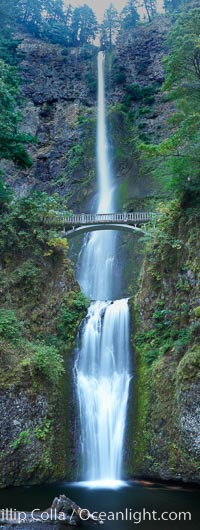
Multnomah Falls. Plummeting 620 feet from its origins on Larch Mountain, Multnomah Falls is the second highest year-round waterfall in the United States. Nearly two million visitors a year come to see this ancient waterfall making it Oregon's number one public destination.
Location: Multnomah Falls, Columbia River Gorge National Scenic Area, Oregon
Image ID: 19313
Panorama dimensions: 12453 x 4705
Location: Multnomah Falls, Columbia River Gorge National Scenic Area, Oregon
Image ID: 19313
Panorama dimensions: 12453 x 4705
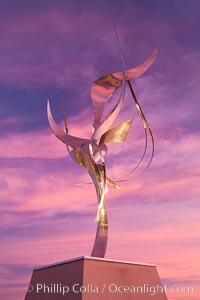
Flama de la Amistad, a statue by Leonardo Nierman. Installed in the San Diego Convention Centerís outdoor amphitheater, Flame of Friendship is a polished, stainless-steel statue set against San Diego Bay weighing 3,700 pounds and standing 20 feet tall and eight feet wide.
Location: San Diego, California
Image ID: 26556
Location: San Diego, California
Image ID: 26556
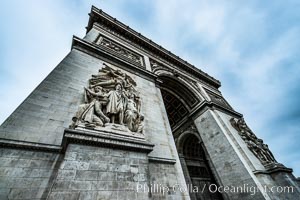
Arc de Triomphe. The Arc de Triomphe (Arc de Triomphe de l'Etoile) is one of the most famous monuments in Paris. It stands in the centre of the Place Charles de Gaulle (originally named Place de l'Etoile), at the western end of the Champs-Elysees. The Arc de Triomphe (in English: "Triumphal Arch") honors those who fought and died for France in the French Revolutionary and the Napoleonic Wars, with the names of all French victories and generals inscribed on its inner and outer surfaces. Beneath its vault lies the Tomb of the Unknown Soldier from World War I. The monument was designed by Jean Chalgrin in 1806, and its iconographic program pitted heroically nude French youths against bearded Germanic warriors in chain mail. It set the tone for public monuments, with triumphant patriotic messages. The monument stands 50 metres (164 ft) in height, 45 m (148 ft) wide and 22 m (72 ft) deep.
Location: Arc de Triomphe, Paris, France
Image ID: 28083
Location: Arc de Triomphe, Paris, France
Image ID: 28083
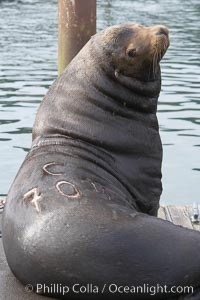
A bull sea lion shows a brand burned into its hide by the Oregon Department of Fish and Wildlife, to monitor it from season to season as it travels between California, Oregon and Washington. Some California sea lions, such as this one C-704, prey upon migrating salmon that gather in the downstream waters and fish ladders of Bonneville Dam on the Columbia River. The "C" in its brand denotes Columbia River. These sea lions also form bachelor colonies that haul out on public docks in Astoria's East Mooring Basin and elsewhere, where they can damage or even sink docks.
Species: California sea lion, Zalophus californianus
Location: Columbia River, Astoria, Oregon
Image ID: 19419
Species: California sea lion, Zalophus californianus
Location: Columbia River, Astoria, Oregon
Image ID: 19419

Sea lion head profile, showing small external ear, prominant forehead typical of adult males, whiskers. This sea lion is hauled out on public docks in Astoria's East Mooring Basin. This bachelor colony of adult males takes up residence for several weeks in late summer on public docks in Astoria after having fed upon migrating salmon in the Columbia River. The sea lions can damage or even sink docks and some critics feel that they cost the city money in the form of lost dock fees.
Species: California sea lion, Zalophus californianus
Location: Columbia River, Astoria, Oregon
Image ID: 19420
Species: California sea lion, Zalophus californianus
Location: Columbia River, Astoria, Oregon
Image ID: 19420

Squid eggs, La Jolla Canyon.
Species: Common squid, Loligo opalescens
Location: La Jolla, California
Image ID: 01972
Species: Common squid, Loligo opalescens
Location: La Jolla, California
Image ID: 01972
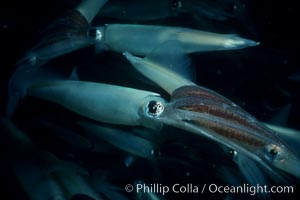
Squid mating.
Species: Common squid, Loligo opalescens
Location: La Jolla, California
Image ID: 02548
Species: Common squid, Loligo opalescens
Location: La Jolla, California
Image ID: 02548
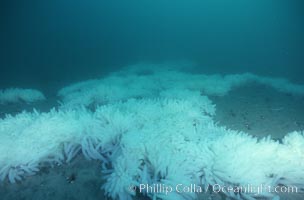
Squid egg clusters on sand.
Species: Common squid, Loligo opalescens
Location: La Jolla, California
Image ID: 05407
Species: Common squid, Loligo opalescens
Location: La Jolla, California
Image ID: 05407
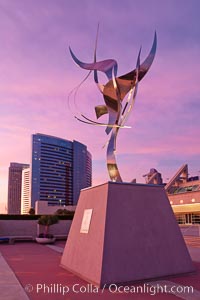
Flama de la Amistad, a statue by Leonardo Nierman. Installed in the San Diego Convention Centerís outdoor amphitheater, Flame of Friendship is a polished, stainless-steel statue set against San Diego Bay weighing 3,700 pounds and standing 20 feet tall and eight feet wide.
Location: San Diego, California
Image ID: 26558
Location: San Diego, California
Image ID: 26558
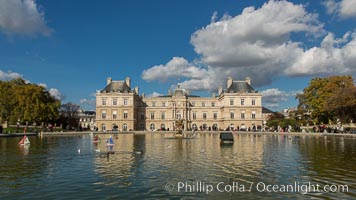
Jardin du Luxembourg. The Jardin du Luxembourg, or the Luxembourg Gardens, is the second largest public park in Paris located in the 6th arrondissement of Paris, France. The park is the garden of the French Senate, which is itself housed in the Luxembourg Palace.
Location: Jardin du Luxembourg, Paris, France
Image ID: 28181
Location: Jardin du Luxembourg, Paris, France
Image ID: 28181
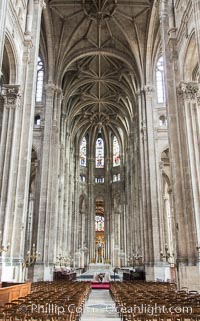
Eglise Saint-Eustache. The Church of St Eustace, Paris a church in the 1st arrondissement of Paris. Situated at the entrance to Paris's ancient markets (Les Halles) and the beginning of rue Montorgueil, St Eustace's is considered a masterpiece of late Gothic architecture.
Location: Eglise Saint-Eustache, Paris, France
Image ID: 28192
Location: Eglise Saint-Eustache, Paris, France
Image ID: 28192
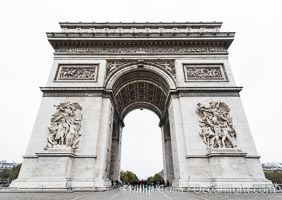
Arc de Triomphe. The Arc de Triomphe (Arc de Triomphe de l'Etoile) is one of the most famous monuments in Paris. It stands in the centre of the Place Charles de Gaulle (originally named Place de l'Etoile), at the western end of the Champs-Elysees. The Arc de Triomphe (in English: "Triumphal Arch") honors those who fought and died for France in the French Revolutionary and the Napoleonic Wars, with the names of all French victories and generals inscribed on its inner and outer surfaces. Beneath its vault lies the Tomb of the Unknown Soldier from World War I. The monument was designed by Jean Chalgrin in 1806, and its iconographic program pitted heroically nude French youths against bearded Germanic warriors in chain mail. It set the tone for public monuments, with triumphant patriotic messages. The monument stands 50 metres (164 ft) in height, 45 m (148 ft) wide and 22 m (72 ft) deep.
Location: Arc de Triomphe, Paris, France
Image ID: 28084
Location: Arc de Triomphe, Paris, France
Image ID: 28084
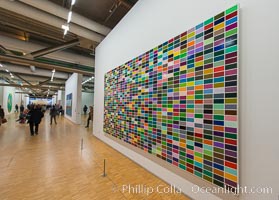
Musee National d'Art Moderne, in Centre Georges Pompidou. Centre Georges Pompidou (also known as the Pompidou Centre) houses the Bibliotheque publique d'information, a vast public library, the Musee National d'Art Moderne which is the largest museum for modern art in Europe, and IRCAM, a centre for music and acoustic research.
Location: Musee National dArt Moderne, Paris, France
Image ID: 28136
Location: Musee National dArt Moderne, Paris, France
Image ID: 28136
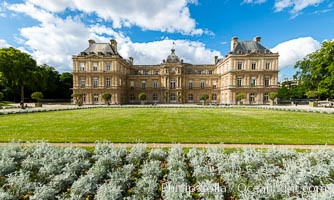
Palais du Luxembourg, Paris. Jardin du Luxembourg. The Jardin du Luxembourg, or the Luxembourg Gardens, is the second largest public park in Paris located in the 6th arrondissement of Paris, France. The park is the garden of the French Senate, which is itself housed in the Luxembourg Palace.
Location: Jardin du Luxembourg, Paris, France
Image ID: 35619
Location: Jardin du Luxembourg, Paris, France
Image ID: 35619

Unstable Cliffs, Stay Back, No Public Access.
Species: Brown Pelican, Pelecanus occidentalis, Pelecanus occidentalis californicus
Location: La Jolla, California
Image ID: 37445
Species: Brown Pelican, Pelecanus occidentalis, Pelecanus occidentalis californicus
Location: La Jolla, California
Image ID: 37445

Jardin du Luxembourg. The Jardin du Luxembourg, or the Luxembourg Gardens, is the second largest public park in Paris located in the 6th arrondissement of Paris, France. The park is the garden of the French Senate, which is itself housed in the Luxembourg Palace.
Location: Jardin du Luxembourg, Paris, France
Image ID: 28180
Panorama dimensions: 3699 x 18309
Location: Jardin du Luxembourg, Paris, France
Image ID: 28180
Panorama dimensions: 3699 x 18309
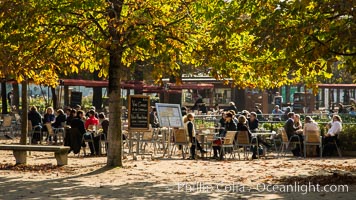
Jardin des Tuileries. The Tuileries Garden is a public garden located between the Louvre Museum and the Place de la Concorde in the 1st arrondissement of Paris. created by Catherine de Medicis as the garden of the Tuileries Palace in 1564.
Location: Jardin des Tuileries, Paris, France
Image ID: 28231
Location: Jardin des Tuileries, Paris, France
Image ID: 28231
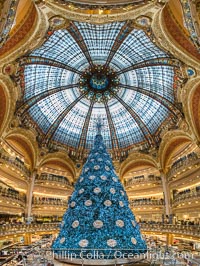
Christmas tree display at les Galeries Lafayette. The Galeries Lafayette is an upmarket French department store company located on Boulevard Haussmann in the 9th arrondissement of Paris.
Location: Galeries Lafayette, Paris, France
Image ID: 28131
Panorama dimensions: 9529 x 7170
Location: Galeries Lafayette, Paris, France
Image ID: 28131
Panorama dimensions: 9529 x 7170
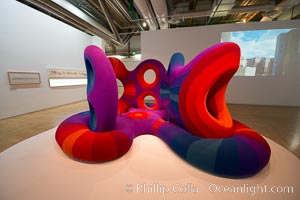
Musee National d'Art Moderne, in Centre Georges Pompidou. Centre Georges Pompidou (also known as the Pompidou Centre) houses the Bibliotheque publique d'information, a vast public library, the Musee National d'Art Moderne which is the largest museum for modern art in Europe, and IRCAM, a centre for music and acoustic research.
Location: Musee National dArt Moderne, Paris, France
Image ID: 28137
Location: Musee National dArt Moderne, Paris, France
Image ID: 28137
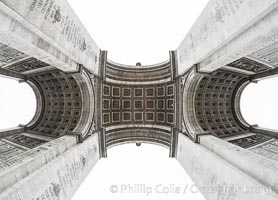
Arc de Triomphe. The Arc de Triomphe (Arc de Triomphe de l'Etoile) is one of the most famous monuments in Paris. It stands in the centre of the Place Charles de Gaulle (originally named Place de l'Etoile), at the western end of the Champs-Elysees. The Arc de Triomphe (in English: "Triumphal Arch") honors those who fought and died for France in the French Revolutionary and the Napoleonic Wars, with the names of all French victories and generals inscribed on its inner and outer surfaces. Beneath its vault lies the Tomb of the Unknown Soldier from World War I. The monument was designed by Jean Chalgrin in 1806, and its iconographic program pitted heroically nude French youths against bearded Germanic warriors in chain mail. It set the tone for public monuments, with triumphant patriotic messages. The monument stands 50 metres (164 ft) in height, 45 m (148 ft) wide and 22 m (72 ft) deep.
Location: Arc de Triomphe, Paris, France
Image ID: 28080
Panorama dimensions: 7793 x 10813
Location: Arc de Triomphe, Paris, France
Image ID: 28080
Panorama dimensions: 7793 x 10813
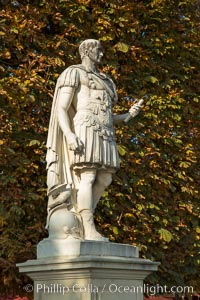
Jardin des Tuileries. The Tuileries Garden is a public garden located between the Louvre Museum and the Place de la Concorde in the 1st arrondissement of Paris. created by Catherine de Medicis as the garden of the Tuileries Palace in 1564.
Location: Jardin des Tuileries, Paris, France
Image ID: 28230
Location: Jardin des Tuileries, Paris, France
Image ID: 28230
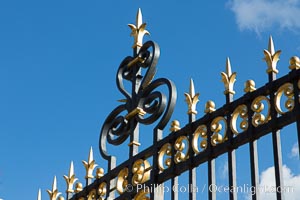
Jardin du Luxembourg. The Jardin du Luxembourg, or the Luxembourg Gardens, is the second largest public park in Paris located in the 6th arrondissement of Paris, France. The park is the garden of the French Senate, which is itself housed in the Luxembourg Palace.
Location: Jardin du Luxembourg, Paris, France
Image ID: 28178
Location: Jardin du Luxembourg, Paris, France
Image ID: 28178
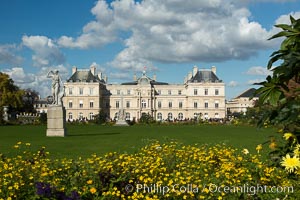
Jardin du Luxembourg. The Jardin du Luxembourg, or the Luxembourg Gardens, is the second largest public park in Paris located in the 6th arrondissement of Paris, France. The park is the garden of the French Senate, which is itself housed in the Luxembourg Palace.
Location: Jardin du Luxembourg, Paris, France
Image ID: 28179
Location: Jardin du Luxembourg, Paris, France
Image ID: 28179
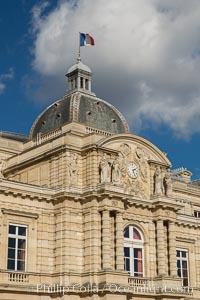
Jardin du Luxembourg. The Jardin du Luxembourg, or the Luxembourg Gardens, is the second largest public park in Paris located in the 6th arrondissement of Paris, France. The park is the garden of the French Senate, which is itself housed in the Luxembourg Palace.
Location: Jardin du Luxembourg, Paris, France
Image ID: 28182
Location: Jardin du Luxembourg, Paris, France
Image ID: 28182
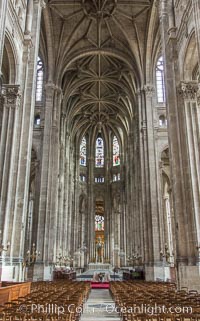
Eglise Saint-Eustache. The Church of St Eustace, Paris a church in the 1st arrondissement of Paris. Situated at the entrance to Paris's ancient markets (Les Halles) and the beginning of rue Montorgueil, St Eustace's is considered a masterpiece of late Gothic architecture.
Location: Eglise Saint-Eustache, Paris, France
Image ID: 28191
Location: Eglise Saint-Eustache, Paris, France
Image ID: 28191

Krill and squid school at the ocean surface, moments before blue and fin whales rise to the surface to feed. The krill is likely Euphausia pacifica, the squid are likely Loligo opalescens. A thin cloud of pink krill gathers at the ocean surface, where it is likely to be preyed upon by sharks, fish, birds and whales.
Species: Common squid, Krill, Euphausia pacifica, Loligo opalescens
Location: San Diego, California
Image ID: 27152
Species: Common squid, Krill, Euphausia pacifica, Loligo opalescens
Location: San Diego, California
Image ID: 27152
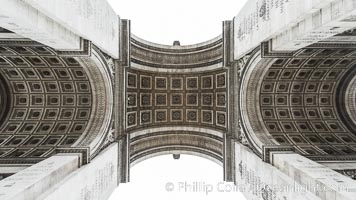
Arc de Triomphe. The Arc de Triomphe (Arc de Triomphe de l'Etoile) is one of the most famous monuments in Paris. It stands in the centre of the Place Charles de Gaulle (originally named Place de l'Etoile), at the western end of the Champs-Elysees. The Arc de Triomphe (in English: "Triumphal Arch") honors those who fought and died for France in the French Revolutionary and the Napoleonic Wars, with the names of all French victories and generals inscribed on its inner and outer surfaces. Beneath its vault lies the Tomb of the Unknown Soldier from World War I. The monument was designed by Jean Chalgrin in 1806, and its iconographic program pitted heroically nude French youths against bearded Germanic warriors in chain mail. It set the tone for public monuments, with triumphant patriotic messages. The monument stands 50 metres (164 ft) in height, 45 m (148 ft) wide and 22 m (72 ft) deep.
Location: Arc de Triomphe, Paris, France
Image ID: 28079
Location: Arc de Triomphe, Paris, France
Image ID: 28079
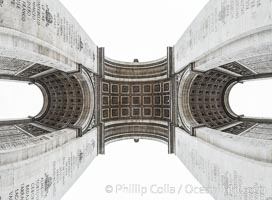
Arc de Triomphe. The Arc de Triomphe (Arc de Triomphe de l'Etoile) is one of the most famous monuments in Paris. It stands in the centre of the Place Charles de Gaulle (originally named Place de l'Etoile), at the western end of the Champs-Elysees. The Arc de Triomphe (in English: "Triumphal Arch") honors those who fought and died for France in the French Revolutionary and the Napoleonic Wars, with the names of all French victories and generals inscribed on its inner and outer surfaces. Beneath its vault lies the Tomb of the Unknown Soldier from World War I. The monument was designed by Jean Chalgrin in 1806, and its iconographic program pitted heroically nude French youths against bearded Germanic warriors in chain mail. It set the tone for public monuments, with triumphant patriotic messages. The monument stands 50 metres (164 ft) in height, 45 m (148 ft) wide and 22 m (72 ft) deep.
Location: Arc de Triomphe, Paris, France
Image ID: 28081
Panorama dimensions: 8402 x 11410
Location: Arc de Triomphe, Paris, France
Image ID: 28081
Panorama dimensions: 8402 x 11410
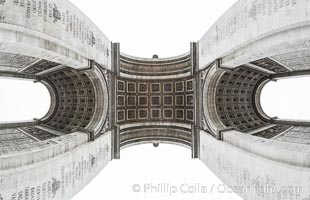
Arc de Triomphe. The Arc de Triomphe (Arc de Triomphe de l'Etoile) is one of the most famous monuments in Paris. It stands in the centre of the Place Charles de Gaulle (originally named Place de l'Etoile), at the western end of the Champs-Elysees. The Arc de Triomphe (in English: "Triumphal Arch") honors those who fought and died for France in the French Revolutionary and the Napoleonic Wars, with the names of all French victories and generals inscribed on its inner and outer surfaces. Beneath its vault lies the Tomb of the Unknown Soldier from World War I. The monument was designed by Jean Chalgrin in 1806, and its iconographic program pitted heroically nude French youths against bearded Germanic warriors in chain mail. It set the tone for public monuments, with triumphant patriotic messages. The monument stands 50 metres (164 ft) in height, 45 m (148 ft) wide and 22 m (72 ft) deep.
Location: Arc de Triomphe, Paris, France
Image ID: 28082
Panorama dimensions: 7420 x 11499
Location: Arc de Triomphe, Paris, France
Image ID: 28082
Panorama dimensions: 7420 x 11499
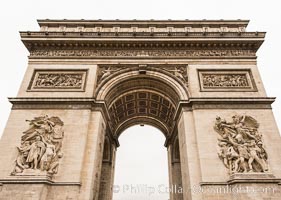
Arc de Triomphe. The Arc de Triomphe (Arc de Triomphe de l'Etoile) is one of the most famous monuments in Paris. It stands in the centre of the Place Charles de Gaulle (originally named Place de l'Etoile), at the western end of the Champs-Elysees. The Arc de Triomphe (in English: "Triumphal Arch") honors those who fought and died for France in the French Revolutionary and the Napoleonic Wars, with the names of all French victories and generals inscribed on its inner and outer surfaces. Beneath its vault lies the Tomb of the Unknown Soldier from World War I. The monument was designed by Jean Chalgrin in 1806, and its iconographic program pitted heroically nude French youths against bearded Germanic warriors in chain mail. It set the tone for public monuments, with triumphant patriotic messages. The monument stands 50 metres (164 ft) in height, 45 m (148 ft) wide and 22 m (72 ft) deep.
Location: Arc de Triomphe, Paris, France
Image ID: 28085
Location: Arc de Triomphe, Paris, France
Image ID: 28085